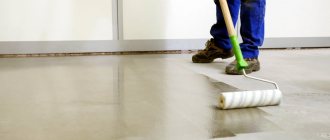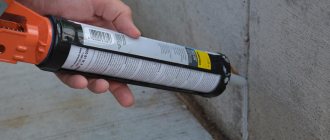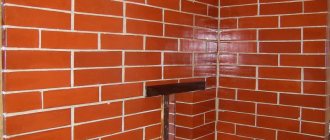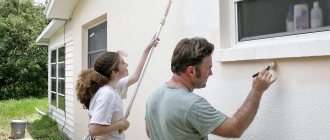Plastering is an integral part of the work performed during the construction of a building or during major repairs. When carrying out finishing work, several types of plaster are used - gypsum, cement, etc. The type of material is selected depending on the requirements for the surface. Let's consider what cement plaster is, its varieties, properties, application technology and what tools are needed for this.
Cement plaster for interior and exterior use
Plaster is a hardened layer of composition used for coating the walls of premises in industrial or civil buildings.
Cement mortar, as the name implies, is based on cement, but it can be replaced with lime, clay or gypsum, but the composition based on cement is in greatest demand. It is durable and has a long service life. It should be noted that the ratio of the components included in the solution may change depending on the main substance of the solution. Cement mortar is mostly used for indoor work, but with the use of certain additives it can also be used for exterior finishing.
Cement mortar is durable and has a long service life.
Features of the solution
Plastering is carried out in several layers, each of them is designed to perform a separate role and has a number of features, let’s look at them in more detail:
- Spray. It is used to form effective adhesion to the main surface and serves as the basis for subsequent layers. In addition, it is used to fill potholes, cracks and other defects of the main surface. The peculiarities of this layer include the fact that it has a liquid composition in appearance, reminiscent of sour cream. Filler with a grain size of up to 2.5 mm is used as a filler;
- Priming. This is the base layer, it is thick, it is applied to the spray layer, the primer creates a flat surface. Sand with a grain size of up to 2.5 mm is used as a filler;
- Covering. This layer is applied to the ground; sand with a chamois size of 1.25 mm is used as a filler; the use of larger grains can lead to the appearance of grooves on the surface.
Plastering is performed in several layers, each of them is designed to perform a separate role and has a number of features.
Technical characteristics of plaster
The plaster mortar can be made independently; enterprises in the construction industry have launched ready-made dry mixtures on the market quite a long time ago; the consumer can only make the right choice, guided by the purpose, scope of work and, of course, financial capabilities
Cement-based plaster mixture is used for both external and internal work. This solution is characterized by high adhesion, strength and long service life. In addition, this solution has low moisture capacity.
To increase the water-repellent parameters of the cement plaster mortar, sealing additives are added to it.
Using cement-based plaster is approximately three times cheaper than using other similar materials. In addition, it has many useful properties.
This solution is characterized by high adhesion, strength and long service life.
Adviсe
Although it is not recommended to influence the drying time of the plaster on its own, if you ensure good air exchange in the room, the likelihood of defects occurring is reduced.
Before plastering the brick, it is better to moisten the surface, since this material has good moisture absorption. Before finishing work, it is necessary to completely clean the surface of any contaminants so that the solution exhibits better adhesion. Do not forget about preparing for plastering the facade - if there are reinforced concrete beams, they are covered with clay baked in a kiln.
It is not advisable to use gypsum plaster for exterior finishing, since it becomes deformed when exposed to rain or snow. To obtain a perfectly even coating, beacons can be installed on the surface. To do this, you first need to check the verticality of the wall, and then drive the dowels in the right places and stretch the fishing line along them. To avoid a break, it is necessary to tighten the fishing line between the outer beacons.
To correct uneven corners, apply an additional layer of plaster. If the unevenness is too large, then first completely knock down the layer of plaster and reapply it.
It is best to carry out plastering in spring or autumn, when there is no hot sun or severe frost. You can cover surfaces from the sun with a special protective canopy.
A thick layer of mortar may crack, but if it is necessary, then it is necessary to stretch a metal reinforcing mesh before applying it. It is advisable to carry out all installation work before plastering, so as not to damage the coating or pipes (wires). Communication elements are placed in special recesses in the wall and covered with plaster. Heating pipes should not be left close to the plaster, as when heated they expand and the coating is destroyed; rust spots may also appear due to the ability of gypsum to absorb moisture.
The surfaces must be completely free of dust, otherwise the plaster will not adhere properly to them.
What are the advantages of cement plaster?
The obvious advantages of cement plaster include the following: low cost; this quality has led to its widespread use.
Another equally important advantage is that you can make it yourself, or you can purchase a ready-made, packaged mixture to make it. It is supplied in bags from 1 to 30 kg. When performing a large volume of work, a ready-made solution can be purchased at the factory.
Ease of use. The fact is that the solution remains quite plastic for a certain time, usually several hours. This allows you to level the surface some time after placing a layer of plaster on the surface to be treated. To correct defects, just spray it with water.
The solution remains quite plastic for a certain time, usually several hours.
Types of cement-based mixtures that are included in the composition
For plastering, many compositions are used, but most often they use a solution made on the basis of cement and sand, cement, and lime. Below we will look at their main properties.
Cement-sand
We can say about cement-sand plaster that it is a very reliable and inexpensive wall covering. During construction, situations may arise when it becomes indispensable. The properties and required parameters are defined in GOST 5802-86, the necessary data is obtained as a result of tests carried out at the factory.
To perform plastering work, the following grades of composition M25, M50 and M100 are used.
- The ratio of sand and cement in the M25 grade is 1/13.5 when using M500 cement, for M400 cement 1/12.5 and for the M300 grade, the ratio is
- For the M50 mixture, the proportions will be: 1/7 with sand - when using M500 cement, 1/6 - for M400, 1/5 - for M300.
- For the M100 mixture, the ratio of components will be: for M500 cement – 1/4.5; for cement M400 – 1/3.5; for M300 – 1/2.5 with sand.
The higher the grade of the composition, the greater the strength, but it makes no sense to use it everywhere, anywhere.
We can say about cement-sand plaster that it is a very reliable and inexpensive wall covering.
Cement-lime
Initially, you need to understand the advantages of these compounds:
- Plastic. Such compositions are easy to apply and resistant to cracking. The cement mixture is prone to cracking, but adding lime eliminates this property.
- Adhesion. The solution fits well on surfaces made of concrete, brick, wood, etc.
- Strength. If a standard mortar easily gets damaged even with minor mechanical stress, then the combination of cement and lime gives the plaster strength and reliability. And ensures a product lifespan of up to 10 years.
- Resistance to biological damage. In particular, to mold. This allows the solution to be used in rooms with high humidity.
Long-term preservation of plasticity, the applied solution retains it for 2-3 hours, this allows you not to rush when doing the work.
Tactical and technical characteristics of the solution:
- Frost resistance - 50 cycles;
- Laying temperature +5 +30 degrees;
- Adhesion 0.3 MPa;
- Compressive strength 3 – 6 MPa;
- For 1 sq.m. consumes up to 18 kg.
Such compositions are easy to apply and resistant to cracking.
Advantages
The material has many positive qualities, including:
- reasonable cost: the ready-made mixture is a quarter cheaper than its gypsum-based counterpart;
- high strength of the finished layer;
- long-term operation reaching fifteen years;
- ease of making a mortar mixture - combine cement and water in the required proportions, mix thoroughly;
- excellent grip on different surfaces;
- resistance to moisture and temperature changes.
To be fair, we note that there are certain disadvantages:
- the solution turns out to be of a thick consistency, viscous, and difficult to work with;
- a thin layer may become cracked when dry;
- the mixture is not applied on top of the plaster;
- the solution does not adhere well to the wood surface;
- the composition adds weight to the walls, increasing the load on the foundation.
Which one is better to choose?
Cement plaster can be used for interior and exterior work. Experience in construction work shows that cement-based plaster is suitable for the listed work.
Cement plaster can be used for interior and exterior work.
For interior work
TsPS plaster can be used for making ceilings and walls. It can also serve for decoration and can act as an intermediate coating. The contents of the composition are responsible for the duration of operation and strength.
Before laying cement plaster for interior work, you will need to assess the state of the microclimate in the room being treated. If it is dry, then it is advisable to use a lime composition. If the microclimate is normal, then it is reasonable to use cement-sand mortar or cement-lime mortar.
Cement composition. Gn is characterized by a long-term strength gain. Until this moment, 12 hours pass. For preparation you will need cement, sand, water; it is permissible to use additives that affect the properties of the cement plaster mixture.
The content of the cement composition looks like this - for the primer composition you will need one part of the binder, two or three parts of the aggregate.
TsPS plaster can be used for making ceilings and walls.
For exterior decoration
Cement-lime plaster is often used for the external coating of a building. This material is often chosen because it adheres well to almost any material used to create the surface.
To obtain a high-quality composition, you first need to prepare a dry mixture, this will require 1 part cement and 5 parts sand, the volume of sand can be changed depending on the requirements for the thickness of the solution. This material must be of high quality, because it depends on how well the work is carried out.
For the most part, grade 400 cement is used to prepare this solution. By the way, before making the solution, it is important to make sure that there are no lumps in the dry cement; their presence will have a negative impact on the quality of the finished composition.
A cement mortar to which lime is added is optimal for working with any surface. To work with cornices and its protruding parts, those cements that have a long service life are used. Cement-lime composition can be used to treat the surfaces of structures made of wood.
The ratio of the components of the solution, depending on the purpose of the solution, may vary from the classic formula 1:1:6 and 1:2:9. We are talking about cement, lime milk and sand.
Cement-lime plaster is often used for the external coating of a building.
Production of cement-lime mortars
Work on the production of such materials begins with slaking lime. For this operation you will need:
- lime;
- capacity;
- clean cold water;
- personal protective equipment (goggles, gloves, thick clothing).
First of all, dry lime is immersed in a container and filled with water. Lime slaking is accompanied by a violent exothermic reaction, so the volume of lime and water should not exceed 30% of the container volume to prevent splashing of the material.
The preparation of cement-lime mortars begins with slaking lime
After 10 minutes, the reaction will subside, so you will need to add water again and leave the mixture to steep for about 1 hour. After this, add some water again, cover the container and let it brew for 2 weeks.
You should know! When using quicklime, the above reaction will occur on the walls, causing the plaster to crack.
After two weeks, you need to remove the lime from the container and rub it through a sieve with a 3 mm mesh. Then mix it with cement in a separate container, and then add sand. For 1 part of cement, it is recommended to use 1 portion of lime and 3 sand. Then you should pour a small amount of water and mix the plaster thoroughly.
Slaked lime is rubbed through a fine mesh sieve.
Cement mortars cannot be soaked with water after they have dried, so it is better to prepare a small amount of material so that it does not have time to dry in the container.
Tools and materials needed for work
To obtain the composition yourself, you will need the availability and use of the following materials and tools:
- An electric drill with a mixer attachment or a professional mixer.
- Water, preferably filtered.
- Screened cement and sand cement.
- Lime dough or milk.
To independently obtain the composition, you will need the availability and use of certain materials and tools.
Application process
To ensure the quality of the plaster layer, a certain sequence is required. Let's look at them below.
Preparing the base
Before laying the plaster, the surface must be prepared, that is, old paint, wallpaper, etc. must be removed from the surface to be treated. In addition, all surface defects must be repaired - cracks, potholes, and crumbling areas must also be treated. Ideally, the surface should be smooth and clean before installation.
Damaged areas are identified by simple visual inspection. To detect hidden defective places, you can knock on the wall with a hammer and if during tapping a dull knock is heard, this indicates the presence of damage.
In these places it is necessary to remove a layer of material; if the holes are deep, then you can lay a reinforcing mesh in them, or simply fill them with nails.
Before laying the plaster, the surface must be prepared, that is, old paint, wallpaper, etc. must be removed from the surface to be treated.
Installation of beacons
Beacon - this guide piece is necessary to guide the rule when leveling the plaster layer. Their use allows you to save up to 30% of the solution, in addition, the work is significantly accelerated. Various methods are used to secure them. The lighthouse itself can be either a galvanized metal profile, or specially made parts, they are called “ears”.
When installing beacons, you will need to use a grueling construction tool, preferably a laser.
Beacon - this guide piece is necessary to guide the rule when leveling the plaster layer.
Preparation of cement mortar
Of course, it is impossible to carry out the work without a ready-made solution; to prepare it you will need the tools listed above. The composition of the solution depends on the operating conditions. For example, a composition with proportions 1:1:6 and 1:2:9. We are talking about cement, lime milk and sand.
The composition of the solution depends on the operating conditions.
Plastering depending on the wall material
The solution is applied in several layers; this can be done manually or using mechanized means. The first layer is called spray, its thickness should be 5 mm. After it dries, a primer layer is applied; it is denser and makes up the base thickness of the entire coating. To ensure a smooth surface, a third layer, called an overlay, is applied. The thickness of this layer is no more than 2 mm.
The solution is applied in several layers; this can be done manually or using mechanized means.
Plaster mortar applied to a wall or other surface creates a reliable barrier to moisture. In addition, it is not susceptible to the effects of biological damage. The low level of thermal conductivity allows you to save costs and thermal energy.
Calculation of the amount of plaster mixture
Before you start mixing, you need to calculate the required amount of solution. As you know, an unprocessed solution is unsuitable for storage, and all that remains is to throw it away, which means that part of the money will be wasted. Let's take a closer look at how to avoid unnecessary costs.
The greatest difficulty in calculations is the curvature of the walls. It is impossible to achieve a perfectly flat surface when building a house, and it is good if the deviations do not exceed 10 mm. But, as practice shows, very often the differences range from 1 to 5 cm, and in some cases even more. When plastering the entire house, calculations must be performed for each wall separately. First you need to determine the average thickness of the plaster layer.
Step 1. The surface of the wall is thoroughly cleaned of the old finish, all noticeable tubercles are knocked down, sagging mortar, if necessary, the seams are cleared.
Dismantling works
Deep recesses and cracks in the wall are sealed separately with cement mortar and allowed to dry thoroughly.
Crack repair
Step 2. Next you will need plaster beacons, which are thin metal slats with perforations. Their thickness is 6 and 10 mm.
Plaster beacons
In a small container, dilute alabaster with water to a thick paste, then apply a level to the wall, determine the vertical and throw the solution along this line at 3-4 points.
How to grow alabaster
Apply the beacon, pressing it into the solution, and check its location with a level. If necessary, press in more or add alabaster. Other beacons are attached in the same way in 1.5 meter increments along the wall.
Beacon for plaster, fixed with alabaster
Some builders use special beacon fasteners with dowels instead of mortar, but for this you will first need to make markings on the wall and then drill holes along the lines. It is easier and faster to work with the solution.
Method of installation of plaster beacons
Step 3. Measure the width of the gaps between the wall and the beacons, and then sum everything up and divide by the number of beacons.
Pay attention to the gap between the lighthouse and the wall
For example, at one point the gap is 2 cm, at another 3.5 cm, at a third place it is generally 5 cm. The more measurements you take, the more accurate the result will be, so measure the deviations under each beacon at several points. Let’s say the total is 30 cm, and there are 10 beacons installed. Divide 30 by 10 and get 3 cm - this is the average thickness of the plaster layer required to calculate the amount of mortar.
Step 4. Now let's find out the total volume of the plaster mixture: to do this, multiply the surface area by the thickness of the layer. For example, the width of the wall is 4.5 m, the height is 2.5 m, the thickness of the plaster layer is 30 mm (0.03 m).
5x2.5x0.03= 0.3375 m3
We round up and get about 340 liters of solution. With a ratio of 1:3, the volume of cement is approximately 112 liters, or 0.1125 m3. The average bulk density of cement is 1500 kg/m3, therefore, by multiplying the volume by the density indicator, we find out the approximate weight of the material: 0.1125x1500 = 168.75 kg.
Since cement is packaged in bags of 50 and 25 kg, you will need to buy 3 large bags and 1 small, or 7 bags of 25 kg. The weight of sand, gypsum, lime and other materials is calculated in a similar way.
Cement in bags
When using factory mixtures, it is easier to perform calculations. The packaging indicates the composition consumption per square meter at a certain layer thickness. If this thickness coincides with the one you got, you just need to multiply the indicated consumption by the working surface area. If it doesn’t match, multiply the consumption by the area and the layer thickness.
Lime plaster mortar, bag 35-40 kg
For example: on the packaging of the Weber Vetonit mixture the consumption is indicated at 2.5 kg/m2 with an application thickness of 2 mm. Our calculated thickness is 30 mm, that is, 15 times more. We calculate how much mixture is needed per 1 square meter:
2.5x15=37.5 kg/m2
Let's say the wall area is 10 m2, then for plaster you will need 375 kg (37.5x10). The standard packaging is 20 kg, so we divide 375 by 20 and get 18.75 bags. This means that for plastering you need to buy 19 bags of the mixture.











